Corporate Accounting and Reporting 1: Impairment Test Regulations
VerifiedAdded on 2020/05/16
|8
|1446
|59
Report
AI Summary
This report provides a comprehensive analysis of corporate accounting and reporting, with a specific focus on impairment testing. It examines the importance of impairment tests in ensuring that assets are not overstated, referencing key accounting standards such as IAS 36 and AASB 136. The report details when impairment tests are mandatory, including for intangible assets with indefinite lives and goodwill. It outlines the indicators of impairment, such as significant declines in asset value, negative changes in the business environment, and rising interest rates. The report also discusses how to determine the recoverable amount of an asset and the circumstances under which an organization may avoid recalculating this amount. It further explores the implications of impairment on the useful life and depreciation methods of an asset. The report is supported by various academic references, providing a robust understanding of the subject matter.
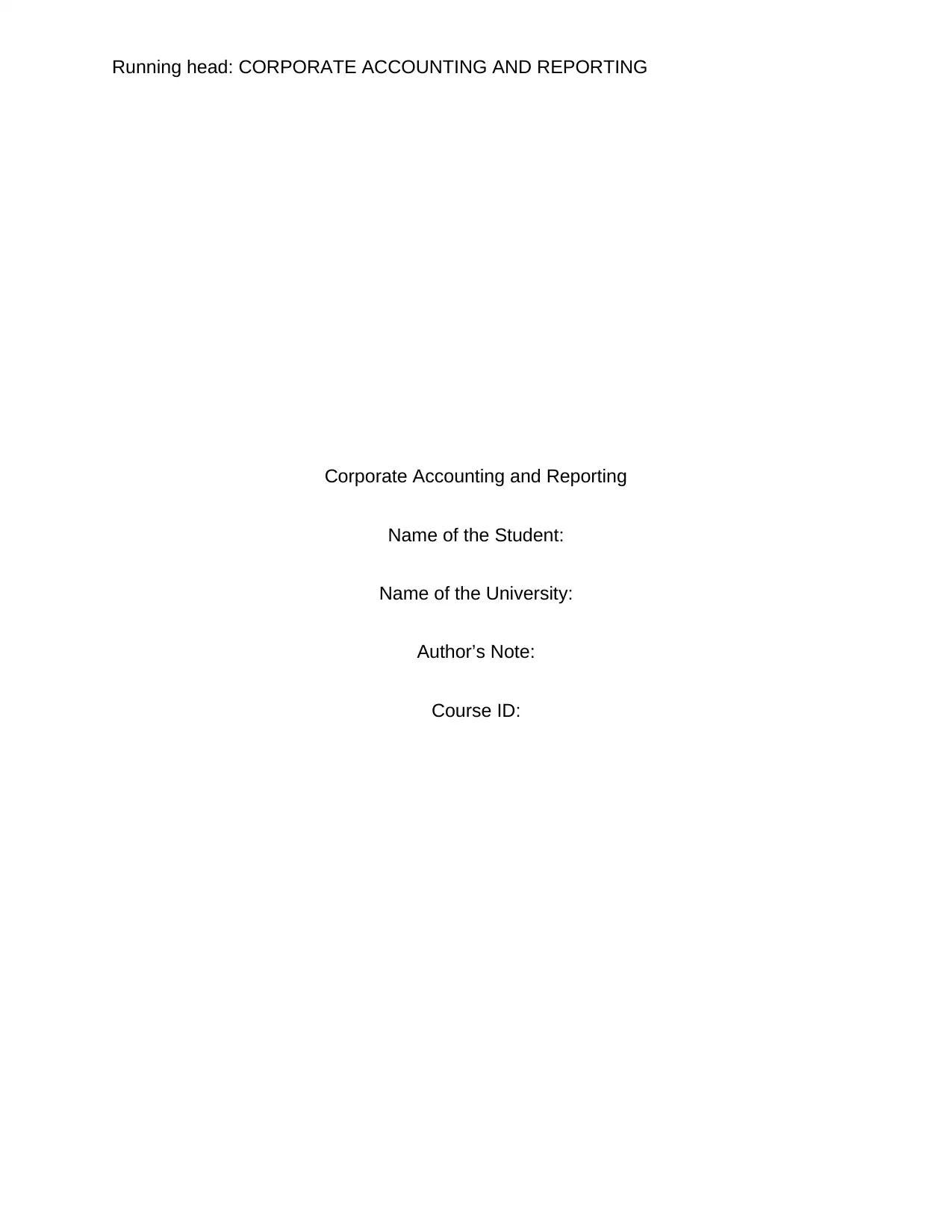
Running head: CORPORATE ACCOUNTING AND REPORTING
Corporate Accounting and Reporting
Name of the Student:
Name of the University:
Author’s Note:
Course ID:
Corporate Accounting and Reporting
Name of the Student:
Name of the University:
Author’s Note:
Course ID:
Paraphrase This Document
Need a fresh take? Get an instant paraphrase of this document with our AI Paraphraser
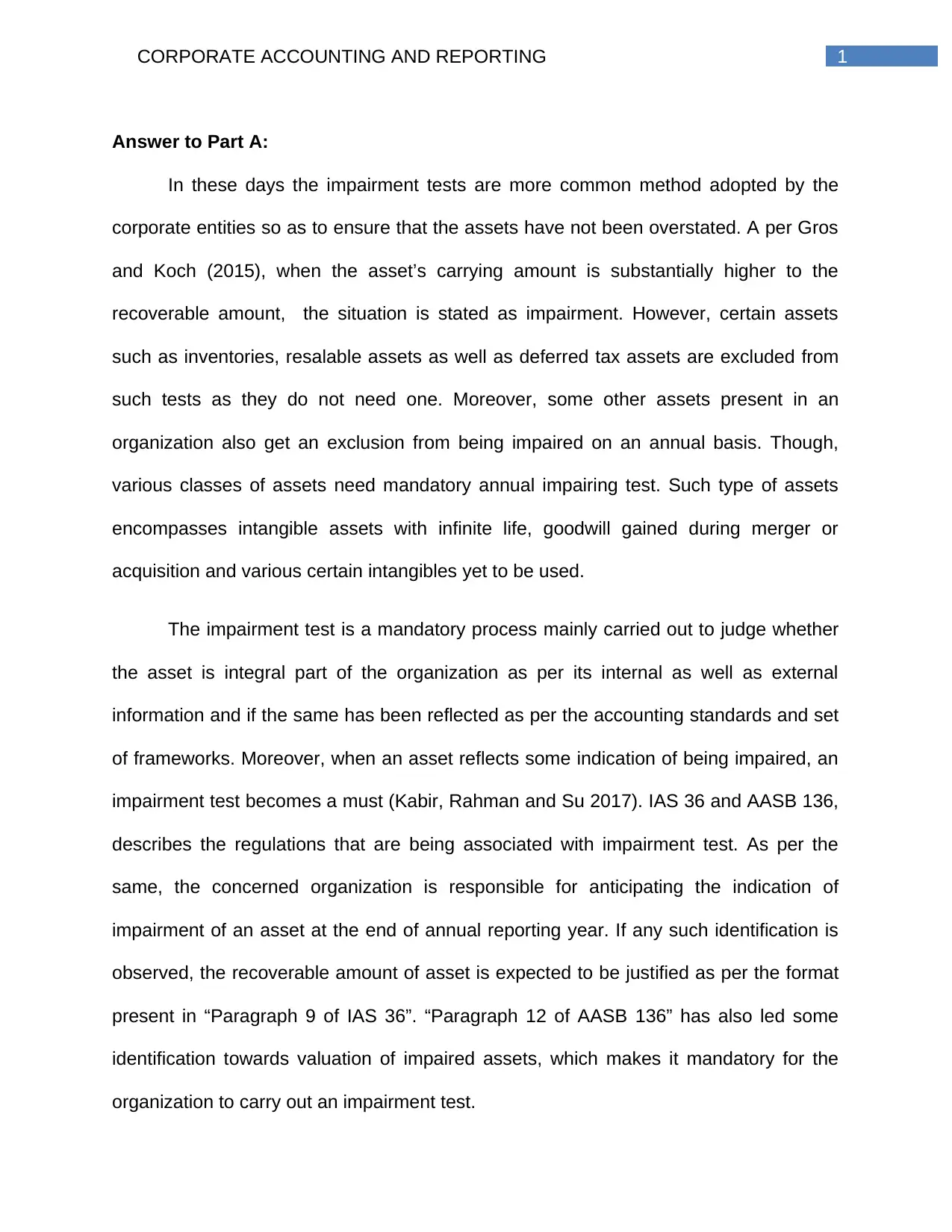
1CORPORATE ACCOUNTING AND REPORTING
Answer to Part A:
In these days the impairment tests are more common method adopted by the
corporate entities so as to ensure that the assets have not been overstated. A per Gros
and Koch (2015), when the asset’s carrying amount is substantially higher to the
recoverable amount, the situation is stated as impairment. However, certain assets
such as inventories, resalable assets as well as deferred tax assets are excluded from
such tests as they do not need one. Moreover, some other assets present in an
organization also get an exclusion from being impaired on an annual basis. Though,
various classes of assets need mandatory annual impairing test. Such type of assets
encompasses intangible assets with infinite life, goodwill gained during merger or
acquisition and various certain intangibles yet to be used.
The impairment test is a mandatory process mainly carried out to judge whether
the asset is integral part of the organization as per its internal as well as external
information and if the same has been reflected as per the accounting standards and set
of frameworks. Moreover, when an asset reflects some indication of being impaired, an
impairment test becomes a must (Kabir, Rahman and Su 2017). IAS 36 and AASB 136,
describes the regulations that are being associated with impairment test. As per the
same, the concerned organization is responsible for anticipating the indication of
impairment of an asset at the end of annual reporting year. If any such identification is
observed, the recoverable amount of asset is expected to be justified as per the format
present in “Paragraph 9 of IAS 36”. “Paragraph 12 of AASB 136” has also led some
identification towards valuation of impaired assets, which makes it mandatory for the
organization to carry out an impairment test.
Answer to Part A:
In these days the impairment tests are more common method adopted by the
corporate entities so as to ensure that the assets have not been overstated. A per Gros
and Koch (2015), when the asset’s carrying amount is substantially higher to the
recoverable amount, the situation is stated as impairment. However, certain assets
such as inventories, resalable assets as well as deferred tax assets are excluded from
such tests as they do not need one. Moreover, some other assets present in an
organization also get an exclusion from being impaired on an annual basis. Though,
various classes of assets need mandatory annual impairing test. Such type of assets
encompasses intangible assets with infinite life, goodwill gained during merger or
acquisition and various certain intangibles yet to be used.
The impairment test is a mandatory process mainly carried out to judge whether
the asset is integral part of the organization as per its internal as well as external
information and if the same has been reflected as per the accounting standards and set
of frameworks. Moreover, when an asset reflects some indication of being impaired, an
impairment test becomes a must (Kabir, Rahman and Su 2017). IAS 36 and AASB 136,
describes the regulations that are being associated with impairment test. As per the
same, the concerned organization is responsible for anticipating the indication of
impairment of an asset at the end of annual reporting year. If any such identification is
observed, the recoverable amount of asset is expected to be justified as per the format
present in “Paragraph 9 of IAS 36”. “Paragraph 12 of AASB 136” has also led some
identification towards valuation of impaired assets, which makes it mandatory for the
organization to carry out an impairment test.
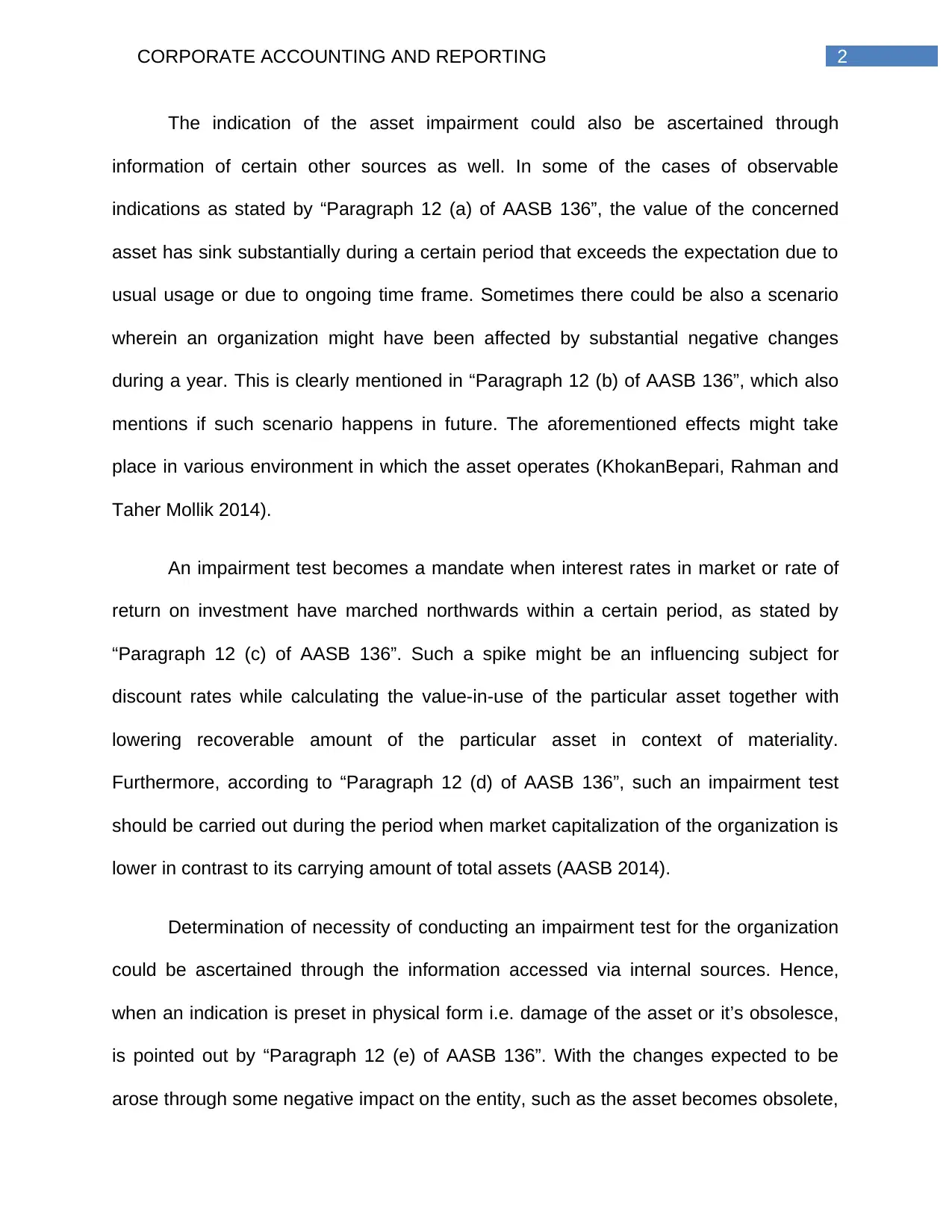
2CORPORATE ACCOUNTING AND REPORTING
The indication of the asset impairment could also be ascertained through
information of certain other sources as well. In some of the cases of observable
indications as stated by “Paragraph 12 (a) of AASB 136”, the value of the concerned
asset has sink substantially during a certain period that exceeds the expectation due to
usual usage or due to ongoing time frame. Sometimes there could be also a scenario
wherein an organization might have been affected by substantial negative changes
during a year. This is clearly mentioned in “Paragraph 12 (b) of AASB 136”, which also
mentions if such scenario happens in future. The aforementioned effects might take
place in various environment in which the asset operates (KhokanBepari, Rahman and
Taher Mollik 2014).
An impairment test becomes a mandate when interest rates in market or rate of
return on investment have marched northwards within a certain period, as stated by
“Paragraph 12 (c) of AASB 136”. Such a spike might be an influencing subject for
discount rates while calculating the value-in-use of the particular asset together with
lowering recoverable amount of the particular asset in context of materiality.
Furthermore, according to “Paragraph 12 (d) of AASB 136”, such an impairment test
should be carried out during the period when market capitalization of the organization is
lower in contrast to its carrying amount of total assets (AASB 2014).
Determination of necessity of conducting an impairment test for the organization
could be ascertained through the information accessed via internal sources. Hence,
when an indication is preset in physical form i.e. damage of the asset or it’s obsolesce,
is pointed out by “Paragraph 12 (e) of AASB 136”. With the changes expected to be
arose through some negative impact on the entity, such as the asset becomes obsolete,
The indication of the asset impairment could also be ascertained through
information of certain other sources as well. In some of the cases of observable
indications as stated by “Paragraph 12 (a) of AASB 136”, the value of the concerned
asset has sink substantially during a certain period that exceeds the expectation due to
usual usage or due to ongoing time frame. Sometimes there could be also a scenario
wherein an organization might have been affected by substantial negative changes
during a year. This is clearly mentioned in “Paragraph 12 (b) of AASB 136”, which also
mentions if such scenario happens in future. The aforementioned effects might take
place in various environment in which the asset operates (KhokanBepari, Rahman and
Taher Mollik 2014).
An impairment test becomes a mandate when interest rates in market or rate of
return on investment have marched northwards within a certain period, as stated by
“Paragraph 12 (c) of AASB 136”. Such a spike might be an influencing subject for
discount rates while calculating the value-in-use of the particular asset together with
lowering recoverable amount of the particular asset in context of materiality.
Furthermore, according to “Paragraph 12 (d) of AASB 136”, such an impairment test
should be carried out during the period when market capitalization of the organization is
lower in contrast to its carrying amount of total assets (AASB 2014).
Determination of necessity of conducting an impairment test for the organization
could be ascertained through the information accessed via internal sources. Hence,
when an indication is preset in physical form i.e. damage of the asset or it’s obsolesce,
is pointed out by “Paragraph 12 (e) of AASB 136”. With the changes expected to be
arose through some negative impact on the entity, such as the asset becomes obsolete,
⊘ This is a preview!⊘
Do you want full access?
Subscribe today to unlock all pages.

Trusted by 1+ million students worldwide
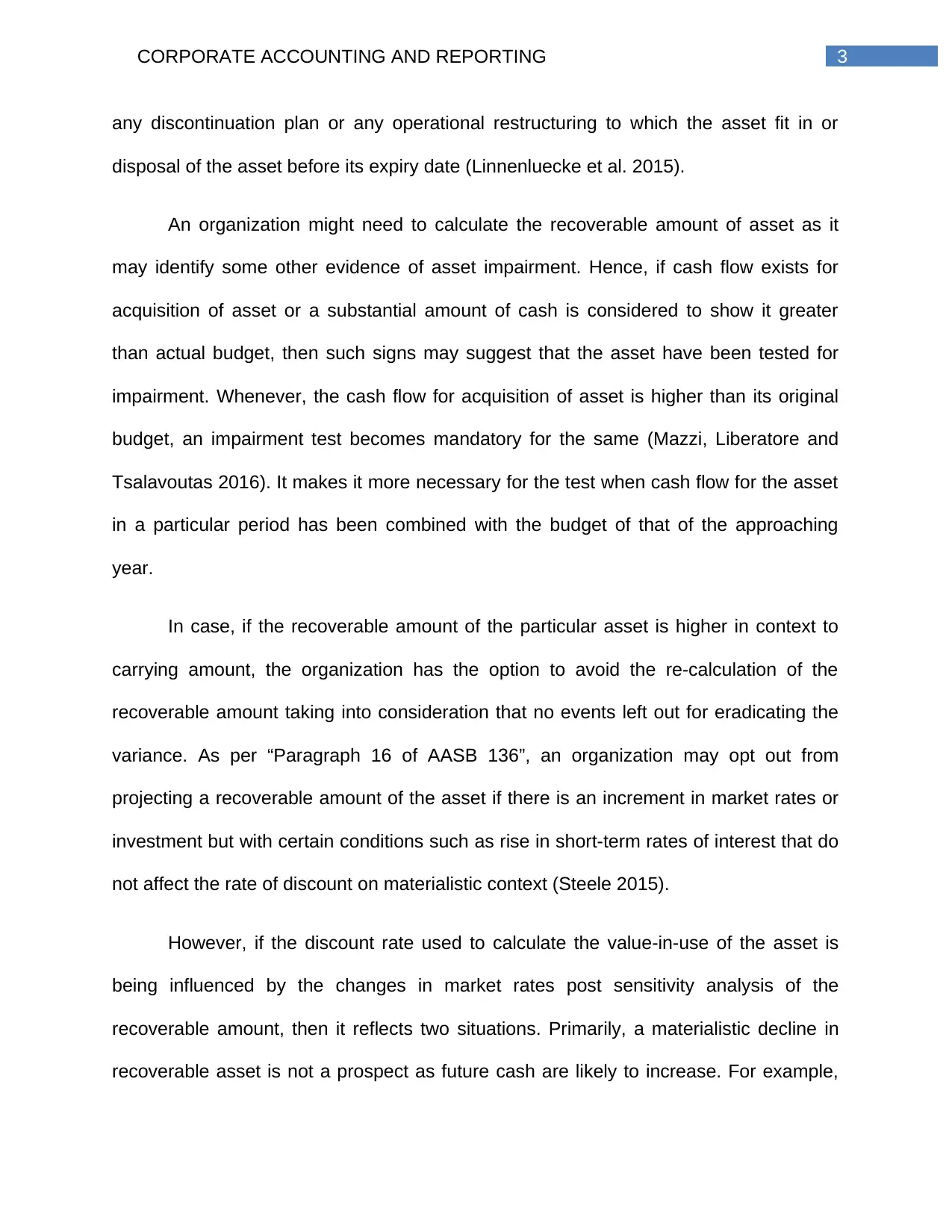
3CORPORATE ACCOUNTING AND REPORTING
any discontinuation plan or any operational restructuring to which the asset fit in or
disposal of the asset before its expiry date (Linnenluecke et al. 2015).
An organization might need to calculate the recoverable amount of asset as it
may identify some other evidence of asset impairment. Hence, if cash flow exists for
acquisition of asset or a substantial amount of cash is considered to show it greater
than actual budget, then such signs may suggest that the asset have been tested for
impairment. Whenever, the cash flow for acquisition of asset is higher than its original
budget, an impairment test becomes mandatory for the same (Mazzi, Liberatore and
Tsalavoutas 2016). It makes it more necessary for the test when cash flow for the asset
in a particular period has been combined with the budget of that of the approaching
year.
In case, if the recoverable amount of the particular asset is higher in context to
carrying amount, the organization has the option to avoid the re-calculation of the
recoverable amount taking into consideration that no events left out for eradicating the
variance. As per “Paragraph 16 of AASB 136”, an organization may opt out from
projecting a recoverable amount of the asset if there is an increment in market rates or
investment but with certain conditions such as rise in short-term rates of interest that do
not affect the rate of discount on materialistic context (Steele 2015).
However, if the discount rate used to calculate the value-in-use of the asset is
being influenced by the changes in market rates post sensitivity analysis of the
recoverable amount, then it reflects two situations. Primarily, a materialistic decline in
recoverable asset is not a prospect as future cash are likely to increase. For example,
any discontinuation plan or any operational restructuring to which the asset fit in or
disposal of the asset before its expiry date (Linnenluecke et al. 2015).
An organization might need to calculate the recoverable amount of asset as it
may identify some other evidence of asset impairment. Hence, if cash flow exists for
acquisition of asset or a substantial amount of cash is considered to show it greater
than actual budget, then such signs may suggest that the asset have been tested for
impairment. Whenever, the cash flow for acquisition of asset is higher than its original
budget, an impairment test becomes mandatory for the same (Mazzi, Liberatore and
Tsalavoutas 2016). It makes it more necessary for the test when cash flow for the asset
in a particular period has been combined with the budget of that of the approaching
year.
In case, if the recoverable amount of the particular asset is higher in context to
carrying amount, the organization has the option to avoid the re-calculation of the
recoverable amount taking into consideration that no events left out for eradicating the
variance. As per “Paragraph 16 of AASB 136”, an organization may opt out from
projecting a recoverable amount of the asset if there is an increment in market rates or
investment but with certain conditions such as rise in short-term rates of interest that do
not affect the rate of discount on materialistic context (Steele 2015).
However, if the discount rate used to calculate the value-in-use of the asset is
being influenced by the changes in market rates post sensitivity analysis of the
recoverable amount, then it reflects two situations. Primarily, a materialistic decline in
recoverable asset is not a prospect as future cash are likely to increase. For example,
Paraphrase This Document
Need a fresh take? Get an instant paraphrase of this document with our AI Paraphraser
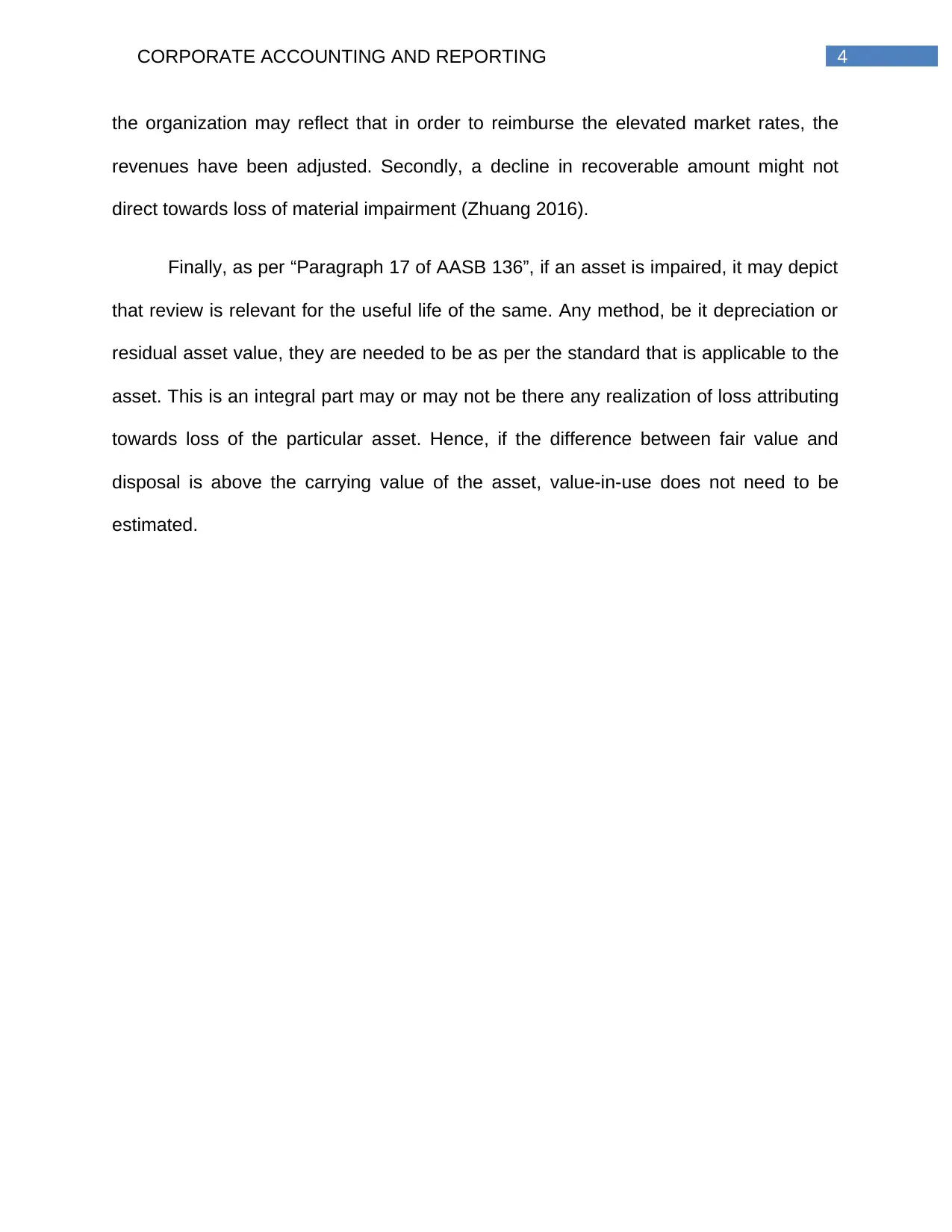
4CORPORATE ACCOUNTING AND REPORTING
the organization may reflect that in order to reimburse the elevated market rates, the
revenues have been adjusted. Secondly, a decline in recoverable amount might not
direct towards loss of material impairment (Zhuang 2016).
Finally, as per “Paragraph 17 of AASB 136”, if an asset is impaired, it may depict
that review is relevant for the useful life of the same. Any method, be it depreciation or
residual asset value, they are needed to be as per the standard that is applicable to the
asset. This is an integral part may or may not be there any realization of loss attributing
towards loss of the particular asset. Hence, if the difference between fair value and
disposal is above the carrying value of the asset, value-in-use does not need to be
estimated.
the organization may reflect that in order to reimburse the elevated market rates, the
revenues have been adjusted. Secondly, a decline in recoverable amount might not
direct towards loss of material impairment (Zhuang 2016).
Finally, as per “Paragraph 17 of AASB 136”, if an asset is impaired, it may depict
that review is relevant for the useful life of the same. Any method, be it depreciation or
residual asset value, they are needed to be as per the standard that is applicable to the
asset. This is an integral part may or may not be there any realization of loss attributing
towards loss of the particular asset. Hence, if the difference between fair value and
disposal is above the carrying value of the asset, value-in-use does not need to be
estimated.
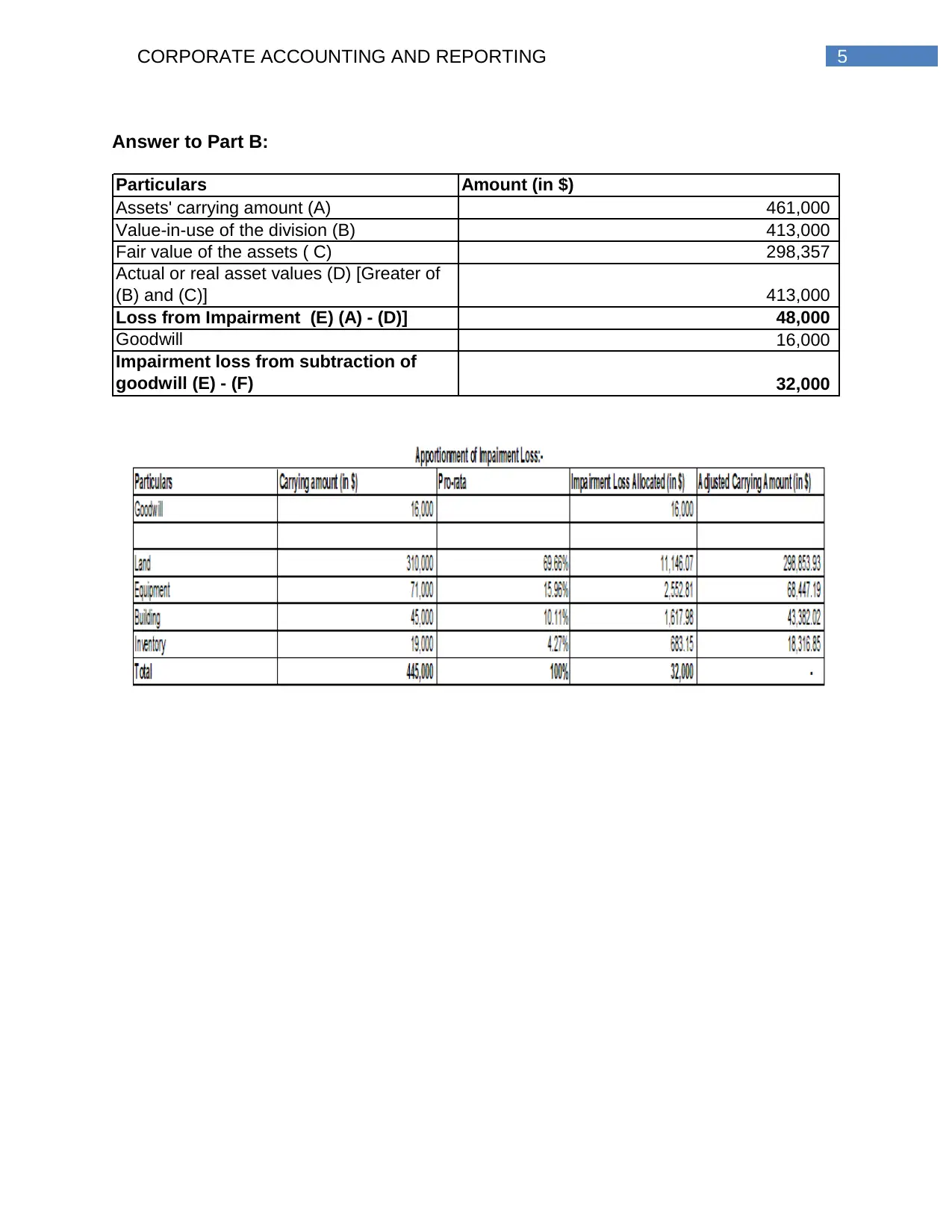
5CORPORATE ACCOUNTING AND REPORTING
Answer to Part B:
Particulars Amount (in $)
Assets' carrying amount (A) 461,000
Value-in-use of the division (B) 413,000
Fair value of the assets ( C) 298,357
Actual or real asset values (D) [Greater of
(B) and (C)] 413,000
Loss from Impairment (E) (A) - (D)] 48,000
Goodwill 16,000
Impairment loss from subtraction of
goodwill (E) - (F) 32,000
Answer to Part B:
Particulars Amount (in $)
Assets' carrying amount (A) 461,000
Value-in-use of the division (B) 413,000
Fair value of the assets ( C) 298,357
Actual or real asset values (D) [Greater of
(B) and (C)] 413,000
Loss from Impairment (E) (A) - (D)] 48,000
Goodwill 16,000
Impairment loss from subtraction of
goodwill (E) - (F) 32,000
⊘ This is a preview!⊘
Do you want full access?
Subscribe today to unlock all pages.

Trusted by 1+ million students worldwide
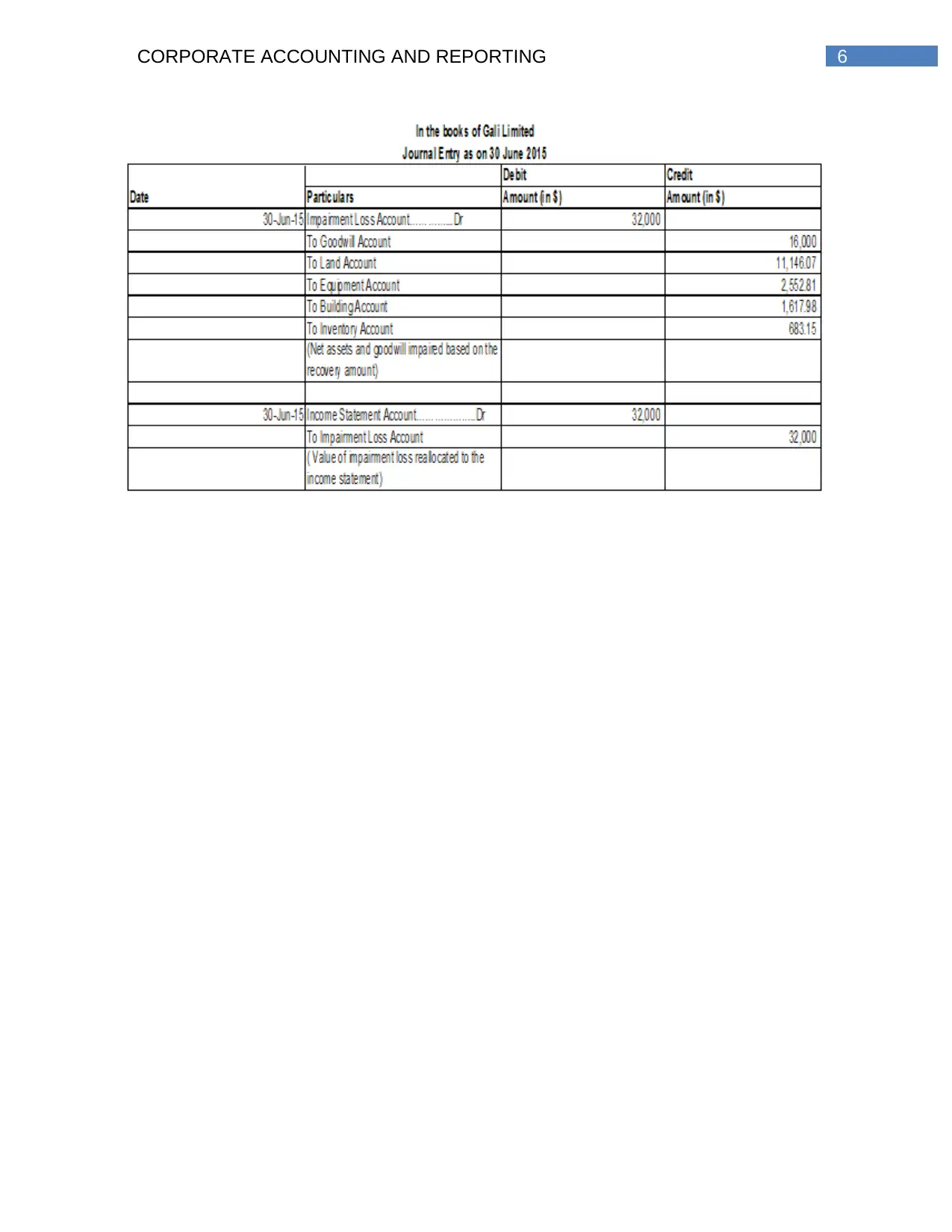
6CORPORATE ACCOUNTING AND REPORTING
Paraphrase This Document
Need a fresh take? Get an instant paraphrase of this document with our AI Paraphraser
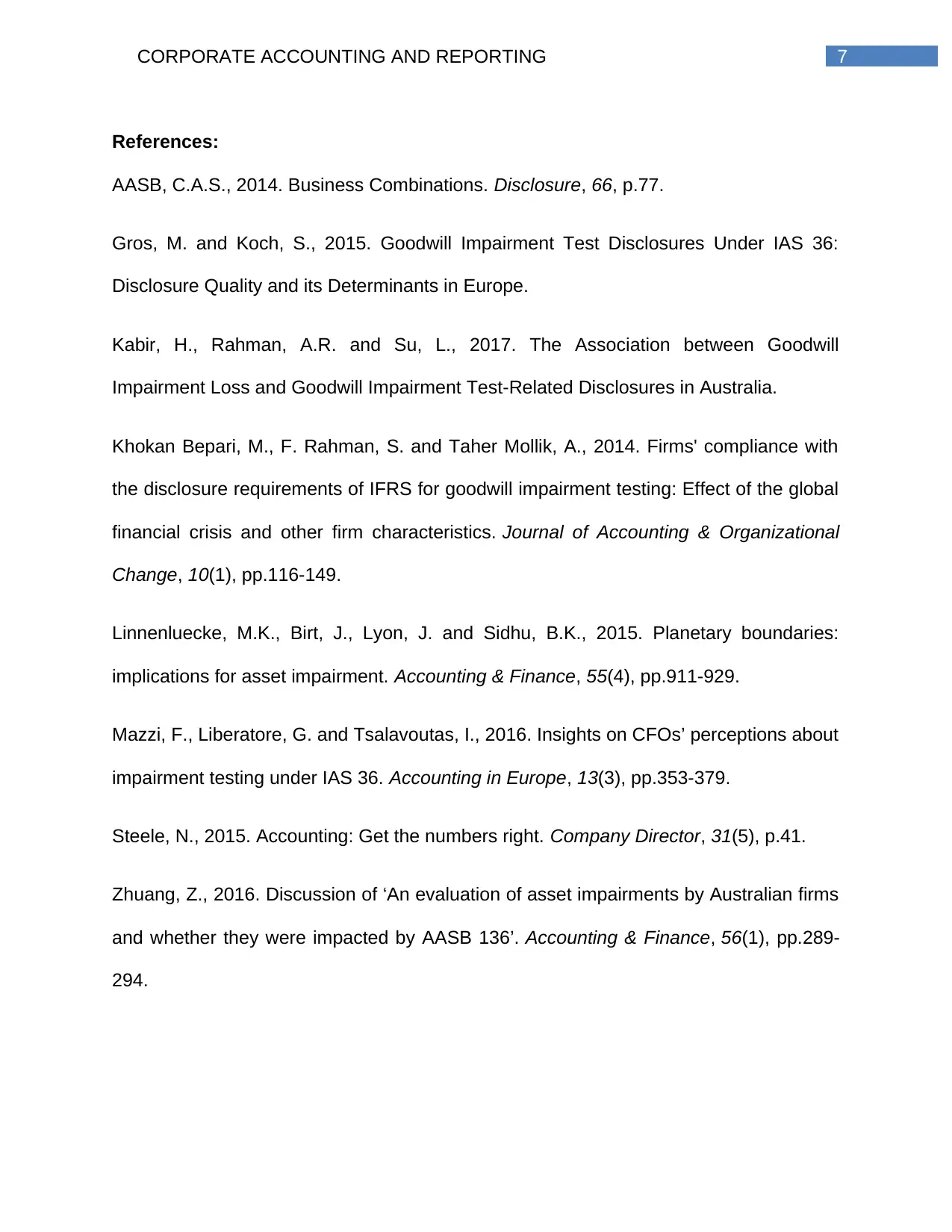
7CORPORATE ACCOUNTING AND REPORTING
References:
AASB, C.A.S., 2014. Business Combinations. Disclosure, 66, p.77.
Gros, M. and Koch, S., 2015. Goodwill Impairment Test Disclosures Under IAS 36:
Disclosure Quality and its Determinants in Europe.
Kabir, H., Rahman, A.R. and Su, L., 2017. The Association between Goodwill
Impairment Loss and Goodwill Impairment Test-Related Disclosures in Australia.
Khokan Bepari, M., F. Rahman, S. and Taher Mollik, A., 2014. Firms' compliance with
the disclosure requirements of IFRS for goodwill impairment testing: Effect of the global
financial crisis and other firm characteristics. Journal of Accounting & Organizational
Change, 10(1), pp.116-149.
Linnenluecke, M.K., Birt, J., Lyon, J. and Sidhu, B.K., 2015. Planetary boundaries:
implications for asset impairment. Accounting & Finance, 55(4), pp.911-929.
Mazzi, F., Liberatore, G. and Tsalavoutas, I., 2016. Insights on CFOs’ perceptions about
impairment testing under IAS 36. Accounting in Europe, 13(3), pp.353-379.
Steele, N., 2015. Accounting: Get the numbers right. Company Director, 31(5), p.41.
Zhuang, Z., 2016. Discussion of ‘An evaluation of asset impairments by Australian firms
and whether they were impacted by AASB 136’. Accounting & Finance, 56(1), pp.289-
294.
References:
AASB, C.A.S., 2014. Business Combinations. Disclosure, 66, p.77.
Gros, M. and Koch, S., 2015. Goodwill Impairment Test Disclosures Under IAS 36:
Disclosure Quality and its Determinants in Europe.
Kabir, H., Rahman, A.R. and Su, L., 2017. The Association between Goodwill
Impairment Loss and Goodwill Impairment Test-Related Disclosures in Australia.
Khokan Bepari, M., F. Rahman, S. and Taher Mollik, A., 2014. Firms' compliance with
the disclosure requirements of IFRS for goodwill impairment testing: Effect of the global
financial crisis and other firm characteristics. Journal of Accounting & Organizational
Change, 10(1), pp.116-149.
Linnenluecke, M.K., Birt, J., Lyon, J. and Sidhu, B.K., 2015. Planetary boundaries:
implications for asset impairment. Accounting & Finance, 55(4), pp.911-929.
Mazzi, F., Liberatore, G. and Tsalavoutas, I., 2016. Insights on CFOs’ perceptions about
impairment testing under IAS 36. Accounting in Europe, 13(3), pp.353-379.
Steele, N., 2015. Accounting: Get the numbers right. Company Director, 31(5), p.41.
Zhuang, Z., 2016. Discussion of ‘An evaluation of asset impairments by Australian firms
and whether they were impacted by AASB 136’. Accounting & Finance, 56(1), pp.289-
294.
1 out of 8
Related Documents
Your All-in-One AI-Powered Toolkit for Academic Success.
+13062052269
info@desklib.com
Available 24*7 on WhatsApp / Email
![[object Object]](/_next/static/media/star-bottom.7253800d.svg)
Unlock your academic potential
Copyright © 2020–2025 A2Z Services. All Rights Reserved. Developed and managed by ZUCOL.



